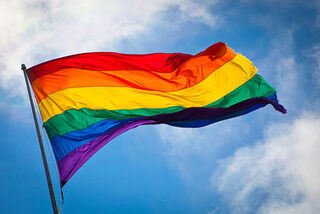Sexual Orientation
Why Is the Word "Homosexual" Considered to Be Offensive?
A look at the controversial history of the term.
Posted May 17, 2021 Reviewed by Kaja Perina
Key points
- Over time, the word "homosexual" has gone from being a label to a slur.
- Historically, "homosexuality" has been demonized as a sin, it has been criminalized and also pathologized.
- Despite popular belief, the word "homosexual" was not mentioned in the Bible until quite recently.

Today is the International Day Against Homophobia, Transphobia, and Biphobia. The date was chosen to commemorate the decision to remove homosexuality from the International Classification of Diseases of the World Health Organization (WHO) in 1990.
In the spirit of this day, let's take a look at the word "homosexual" to understand why it is now considered to be offensive.
Same-sex attraction or “homosexuality” is the state of “being sexually or romantically attracted to people of one’s own sex.” Gay, lesbian, bisexual, and queer are the main preferred terms to describe people who are attracted to members of the same sex. This sexual orientation is the opposite of “heterosexuality”, a “sexual attraction to individuals of the opposite sex,” which is known colloquially as being “straight.” (This is contrasted with “bent” as slang for gay.)
Before the word “homosexuality" emerged, sexual relationships between men were labeled “sodomy.” Sodomy is derived from Latin Sodoma, the name of the town in the Biblical tale of Sodom and Gomorrah. The Book of Genesis (19) describes these cities as depraved, and their destruction by fire as divine judgment from God. Sodom has become synonymous with “homosexuality”. As a result of this association, there is a long history of the criminalization of gay sexual activity. Historically, “Sodomy laws” condemned sexual acts other than heterosexual intercourse, but especially oral sex and anal sex between men. Performing an act of sodomy made one a “sodomite”, and brutal punishments have been metered out in the past. In Medieval Christian Europe, sodomites were burned at the stake, based on the fire and brimstone fate of Sodom and Gomorrah in the Bible. During the European colonization of the Americas, the Spanish conquistadors subjected “Indian sodomites” to severe punishments, including public execution or being torn to pieces by dogs.
The History of Biblical Mentions
“Homosexuality” is no longer considered to be a crime in many countries, although some people still consider it to be a sin. In part, this is based on the Biblical tale of Sodom and Gomorrah. Ironically, these passages do not explicitly identify gay sex as the “sin” for which the cities were destroyed. Conservative Christians believe that God made men and women to complete each other and to procreate. Gay sex is not reproductive, so they perceive it as sexual deviancy. It is branded “immoral”, “depraved” and “perverse”. They say that gay sex is not the “normal” kind of sex, and that such sexual relationships do not create a “normal” family. Gay sex is described as the “creation of the devil” that goes “against God’s law” and is an “abomination”. Several key passages from the Bible are interpreted as prohibitions against same-sex acts. Leviticus (18:22) says, “You shall not lie with a male as with a woman; it is an abomination,” while Leviticus (20:13) adds, “If a man lies with a male as with a woman, both of them have committed an abomination; they shall surely be put to death; their blood is upon them.” The following passages of Scripture are also invoked to support the belief that gay sex is a sin: 1 Samuel 18:1, 2 Samuel 1:26, Judges 19:22, Peter 2:6–10, 1 Kings 14:24, 1 Kings 15:12, Jude 1:7, Matthew 8, Luke 7, 1 Timothy 1:8–10, Romans 1:18–32, and 1 Corinthians 6.
However, this is open to interpretation. In the First Epistle to the Corinthians (6:9–10), Paul the Apostle refers to wrongdoers who “will not inherit the kingdom of God” using the Greek words malakoi and arsenokoitai. These are translated in the New Revised Standard Version of the Bible as “male prostitutes” and “sodomites” respectively, but their original meanings are highly debated. Malakoi literally meant “soft” and is used in the Bible elsewhere (Matthew 11:8 and Luke 7:25), where it has nothing to do with any kind of sexual behavior. Malakoi was never used in reference to same-sex sexual behavior, while the word appears in writings contemporary with the Epistles of Paul in reference to straight people and activities. Malakoi may instead refer to a man who is morally weak, lacking in courage, or effeminate. The precise meaning of arsenokoitai is not known. It appears for the very first time in 1 Corinthians, although it is speculated that it referred to the sexual abuse or exploitation of individuals. At the time, names for people who engaged in same-sex behavior already existed, including paiderastes, pallakos, kinaidos, arrenomanes, and paidophthoros, but these words are not used, while malakoi and arsenokoitai were never used specifically to refer to gay people.
Despite these spurious interpretations, modern translations of this passage make explicit references to “homosexuality”. The English Standard Version (2011) translates both malakoi and arsenokoitai as “men who practice homosexuality”. The book states, “Or do you not know that the unrighteous will not inherit the kingdom of God? Do not be deceived: neither the sexually immoral, nor idolaters, nor adulterers, nor men who practice homosexuality, nor thieves, nor the greedy, nor drunkards, nor revilers, nor swindlers will inherit the kingdom of God.”
The Concept of Same-Sex Attraction
However, the concept of same-sex attraction as a sexual orientation is relatively new, and the words “homosexual” and “homosexuality” did not emerge until 1869, when they were coined by Hungarian journalist Károli Mária Kertbeny. “Homosexuality” did not appear in any Bible translation until 1946, when the Revised Standard Version of the Bible collapsed malakos and arsenokoitai into one word: “homosexuals”. Other versions of the Bible provide judgmental translations. The 1973 edition translates these words as “sexual perverts”, the Jerusalem Bible uses “catamites” and “sodomites”, and the New International Version (NIV) favors the terms “male prostitutes” and “homosexual offenders.”
In light of negative usages such as these modern Biblical references, “homosexual” is not a neutral term; it is a slur. Through its association with anti-gay attitudes, “homosexual” has acquired negative connotations of disapproval and judgment. The early gay rights movement was instead called the “homophile movement” because activists rejected the word “homosexual” and its negative implications. “Homosexual” is further sensationalized because it contains the word “sex”. This places an emphasis on sex, although for gay people, their sexuality is merely an attribute of their humanity. “Homosexual” also contains the prefix, -homo, which has been used as a slur. “Homo” is often coupled with descriptors that portray same-sex attraction as something disgusting, unclean, or impure, such as dirty homo and filthy homo. As a result of these negative associations, “homosexual” is considered derogatory when referring to people. Same-sex-oriented people eschew the use of “homosexual” as a self-identifying label, instead referring to themselves by a range of preferred terms, most commonly “gay”, “lesbian”, “bisexual”, or “queer”. In most usage today, “homosexual” is perceived as old-fashioned, distancing, and clinical.
Historically, the word “homosexuality” had medical implications. Until quite recently, same-sex attraction was pathologized as a “disease”, “sickness”, “defect”, “disorder”, or as a mental illness. (This is still the case in some communities.) Same-sex attraction has been presented as a danger to society, to families, and to children in particular. It has been associated with sexual perversion, such as pedophilia, child abuse, incest, and bestiality (hearkening back to the earlier definition of “buggery”). This theory held that “homosexuality” had a psychological or physiological basis, such as a trauma to the brain, sexual abuse, having had a dominant opposite-gender parent, or absent same-gender parent. It has also been linked to the effects of watching pornography or eating foods containing soy. The idea that “homosexuality” had a cause led to the belief that it could be “cured” by psychiatrists, psychologists, or physicians. Psychiatric treatments included cognitive-behavioral techniques, hypnosis, aversion therapy, electroconvulsive therapy, and lobotomy. Medical and surgical attempts to change sexual orientation included hormone treatments, hysterectomy, vasectomy, and castration.
During the Holocaust, thousands of gay men were imprisoned in Nazi concentration camps, while some were experimented upon in an effort to “cure” their sexuality. It was not until 1973 that the American Psychiatric Association removed the diagnosis of “homosexuality” from its list of mental disorders in the second edition of its Diagnostic and Statistical Manual (DSM).
Given the word's loaded past, it's clear to see why "homosexual" is now perceived as a homophobic term that is eschewed by stakeholders and their allies.




